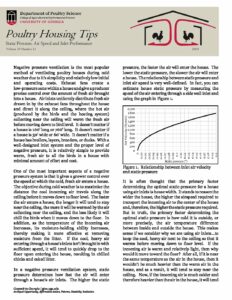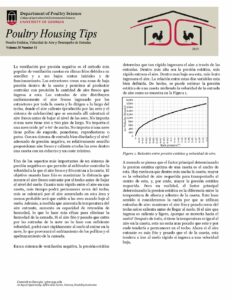Negative pressure ventilation is the most popular method of ventilating poultry houses during cold weather due to it’s simplicity and relatively low initial and operating costs. Exhaust fans create a low-pressure zone within a house and give a producer precise control over the amount of fresh air brought into a house. Air inlets uniformly distribute fresh air drawn in by the exhaust fans throughout the house and direct it along the ceiling, where the hot air (produced by the birds and the heat...ing system) collecting near the ceiling will warm the fresh air before moving down to bird level. It doesn't matter if a house is 100' long or 700' long. It doesn't matter if a house is 30' wide or 60' wide. It doesn’t matter if a house has broilers, layers, breeders, or ducks. With a well-designed inlet system and the proper level of negative pressure, it is relatively simple to provide warm, fresh air to all the birds in a house with minimal amount of effort and cost.
One of the most important aspects of a negative pressure system is that it gives a grower control over the speed at which the cold, fresh air enters a house. The objective during cold weather is to maximize the distance the cool incoming air travels along the ceiling before it moves down to floor level. The faster the air enters a house, the longer it will tend to stay near the ceiling, the more it will be warmed by the air collecting near the ceiling, and the less likely it will chill the birds when it moves down to the floor. In addition, as the temperature of the incoming air increases, its moisture-holding ability increases, thereby making it more effective at removing moisture from the litter. If the cool, heavy air entering through a house's inlets isn’t brought in with sufficient speed, it will tend to quickly drop to the floor upon entering the house, resulting in chilled chicks and caked litter.
In a negative pressure ventilation system, static pressure determines how fast the air will enter through a house's air inlets. The higher the static pressure, the faster the air will enter the house. The lower the static pressure, the slower the air will enter a house. The relationship between static pressure and inlet air speed is very well-defined. In fact, you can estimate house static pressure by measuring the speed of the air entering through a side wall inlet and using the graph in Figure 1.
It is often thought that the primary factor determining the optimal static pressure for a house using air inlets is house width. It stands to reason the wider the house, the higher the airspeed required to transport the incoming air to the center of the house and, therefore, the higher the static pressure required. But in truth, the primary factor determining the optimal static pressure is how cold it is outside, or more precisely, the air temperature difference between inside and outside the house. This makes sense if we consider why we are using air inlets...to keep the cool, heavy air next to the ceiling so that it warms before moving down to floor level. If the incoming air is warm and relatively light, then why would it move toward the floor? After all, if it is near the same temperature as the air in the house, then it wouldn't be much heavier than the warm air in the house, and as a result, it will tend to stay near the ceiling. Now, if the incoming air is much colder and therefore heavier than the air in the house, it will tend to fall to the floor quickly if it enters the house at a low air speed.
Equations have been developed to estimate how far air entering through an air inlet will travel along the ceiling before moving down to floor level based on various factors (i.e., static pressure, inlet opening size, inlet type, inlet position, etc). Though they don’t provide precise answers for every situation, these equations can be used to explore how factors such as inside/outside temperature differences affect the performance of an inlet system. For instance, for a typical European style inlet positioned near a smooth ceiling, opened two inches, at a static pressure of 0.11", an air jet will travel approximately 26' along a ceiling before moving down to floor level when it is 70oF outside and 80oF inside (Table 1). But if the outside temperature falls to 30oF, the travel distance will be cut to just 11'! As a result, during a fall afternoon, the air entering through an inlet could easily be making it to the center of a 50' wide house, but at night, relatively cool incoming air could be falling to the floor a little over ten feet from the side wall. The environment for the birds could be great in the afternoon and relatively chilly at night with the same exhaust fans, inlet opening, and static pressure. This is why it is so important for growers to evaluate inlet performance when outside temperatures are at the lowest. If they are acceptable first thing in the morning or late at night, chances are they will be fine as outside temperatures climb during the day.
Static
Pressure Outside Temperature
70oF 50oF 30oF 10oF
0.05" 18' 10' 8' 6'
0.07" 21' 12' 9' 8'
0.09" 24' 14' 10' 8.5'
0.11" 26' 15' 11' 9'
0.13" 29' 16' 12' 10'
0.15" 31' 17' 13' 11'
Table 1. Theoretical distance air from an European inlet, located at the top of side wall, will travel along a smooth ceiling when it is opened two inches with a house temperature of 80oF (From equation developed by Dr. Steven Hoff, Iowa State University).
Though higher inlet air speeds are generally required as outside temperatures fall, it is important to realize that simply increasing controller static pressure settings may not improve the performance of side wall inlets. This is because a poultry house controller increases static pressure by decreasing inlet opening size. As you might suspect, as inlet opening size decreases, the throw of air from an air inlet decreases. This is why it is sometimes best to increase the static pressure by closing a portion of houses inlets (i.e, 1/4, 1/3, etc.). This will enable a grower to increase the pressure and not reduce the opening size of individual inlets.
What is the correct operating static pressure? Though there isn't a specific static pressure that will work in all instances, a pressure between 0.05" and 0.13" (900 and 1,400 ft/min) is generally recommended for use in most poultry houses. Lower static pressure settings work best during moderate to warm weather with larger inlet openings (two inches or greater). In comparison, higher static pressure settings are better suited for colder weather with smaller inlet openings (one to two inches).
Determining the optimal static pressure and inlet opening will require experimentation. Producers can see the airflow pattern from an inlet by attaching a five-to-ten-inch piece of survey tape to the ceiling every few feet from the side wall to the peak of the ceiling directly in front of an inlet or two. When the minimum ventilation fans are operating, the survey tape nearest the side wall should be blown parallel to the ceiling, while those nearest the ceiling peak should barely move, indicating that the air is slowly moving down towards the floor. Since inlet performance will vary with outside temperature, producers should make observations throughout the day, with particular attention paid early in the morning and late at night when outside temperatures are at their lowest. Producers will often find if they can get the incoming air to make it to near the center of the house during the coolest portions of the day, that inlet performance will only improve as outside temperatures increase over the course of the day.
ATTACHMENTS
Details
| Year | Volume | Number | Categories |
|---|---|---|---|
| 2023 | 35 | 11 |


